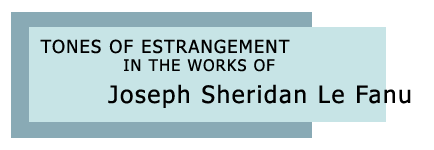Introduction
Joseph Sheridan Le Fanu (1814-1873) was among the stars of Victorian gothic writers. His writings include gothic novels, ghost and mystery stories,
fantastic tales and historical romances. Today, sadly, his popularity has faded. Sad, indeed, as he was a great innovator within his preferred genres and a
source of inspiration for other writers, such as Bram Stoker or Emily Brontë, who have retained appeal to a modern readership. Le Fanu's achievements
are not forgotten, however, and he continues to draw modern readers. The novels "The House by the Churchyard" (1861) and "Uncle Silas" (1864), the vampire
tale "Carmilla" (1872) and the short story "Green Tea" (1869) are among those of his works which are considered his finest and which have endured in their
popularity and acclaim. We have in part M. R. James (1862-1936), the renowned ghost story writer, to thank for the re-discovery of Le Fanu, who had by
the beginning of the twentieth century been all but forgotten, until James in 1923 arranged to re-publish a number of Le Fanu's tales and ghost stories
and restored Le Fanu to a popular reading audience. In his appreciation of Le Fanu, James stressed in particular Le Fanu's ability at engaging the
imagination of the reader and invoking the sensation of terror. To James, Le Fanu surpassed all other writers in this respect.
It is not, however, Le Fanu's proficiencies in genre and his aptitude for generating terror with which this website will primarily concern itself. Within
Le Fanu's tales lies an underlying tone of estrangement which reflects the estrangement of an Irish writer who is not Irish. Le Fanu revisits the same
themes time and time again; isolation, estrangement, banishment, hauntings, and the return of the dead. Classic gothic conventions which serve both the
writer in his expression and the reader in his or her understanding of the writer and his works.
The intention behind this website is that it should serve as a study guide and reference source on Le Fanu. It is intended for senior high school and
college entry level students, but both persons new to Le Fanu and those familiar may find this website helpful. I
have included a biography and list of resources, and an analysis of one of Le Fanu's tales, "The Child that went with Faeries". A glossary of relevant
terms is also included on this website. Finally, I have compiled a list of questions which can be considered in a study of Le Fanu's works.
About this Website
This site has been tested for optimal performance on Internet Explorer and Mozilla. Safari is also supported. If you prefer a larger or smaller text,
simply select an alternate text or font size in your browser's "View" menu. My css coding does not lock text to a specific size. All links which lead
outside this site will open in a new window.
If you would like to link to this site, you may use the logo below. Please do not refer to this site for the image source.

Email riddler provided by
[ Dynamic Drive ]
All content Copyright (C) 2006, 2010 Kirstin Sørensen, except when stated otherwise.
About the Webmistress
I am a student of English at Aarhus University, Denmark. My main interests are genre and aesthetic theory. I am also an amateur web designer and this
website constitutes one of my exams in literature. I hope you enjoy my website. Please also visit the rest of
[ VarlaWeb ].
You can get in touch with VarlaWeb with this
or write a message in the guestbook. Any comments, suggestions or questions are welcome. Your feedback is valuable.
News
June 2006 : Site launched.
June 2010 : The site has recieved some alterations. Conversion into php. A guestbook has been added. Slight extension of the glossary content.
Analysis of "The Child that went with Faeries" has been extended. Resource list reviewed. New header.



